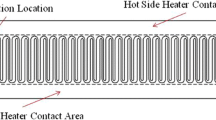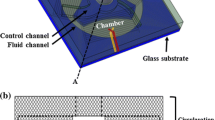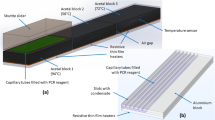Abstract
This study investigated the effect of exposing a polymerase chain reaction (PCR) mixture to capillary tubing of different materials and lengths, at different contact times and flow rates and the adsorption of major reaction components into the tubing wall. Using 0.5 mm ID tubing, lengths of 40 cm and residence times up to 45 min, none of the tested polymeric materials was found to affect subsequent PCR amplification. However, after exposure of the mixture to tubing lengths of 3 m or reduction of sample volume, PCR inhibition occurred, increasing with the volume to length ratio. Different flow velocities did not affect PCR yield. When the adsorption of individual PCR components was studied, significant DNA adsorption and even more significant adsorption of the fluorescent dye Sybr Green I was found. The results indicate that PCR inhibition in polymeric tubing results from adsorption of reaction components to wall surfaces, increasing substantially with tubing length or sample volume reduction, but not with contact time or flow velocities typical in dynamic PCR amplification. The data also highlight that chemical compatibility of polymeric capillaries with DNA dyes should be carefully considered for the design of quantitative microfluidic devices.





Similar content being viewed by others
References
J.F. Allemand, D. Bensimon, L. Jullien, A. Bensimon, and V. Croquette, pH-dependent specific binding and combing of DNA. Biophys. J. 73(4), 2064–2070 (1997).
M. Arya, I.S. Shergill, M. Williamson, L. Gommersall, N. Arya, and H.R. Patel, Basic principles of real-time quantitative PCR. Expert. Rev. Mol. Diagn. 5(2), 209–219 (2005).
K.D. Dorfman, M. Chabert, J.H. Codarbox, G. Rousseau, P. de Cremoux, and J.L. Viovy, Contamination-free continuous flow microfluidic polymerase chain reaction for quantitative and clinical applications. Anal. Chem. 77(11), 3700–3704 (2005).
I. Erill, S. Campoy, N. Erill, J. Barbe, and J. Aguilo, Biochemical analysis and optimization of inhibition and adsorption phenomena in glass-silicon PCR-chips. Sensors and Actuators B-Chem. 96(3), 685–692 (2003).
B.C. Giordano, E.R. Copeland, and J.P. Landers, Towards dynamic coating of glass microchip chambers for amplifying DNA via the polymerase chain reaction. Electrophoresis 22(2), 334–340 (2001).
L.J. Kricka and P. Wilding, Microchip PCR. Anal. Bioanal. Chem. 377(5), 820–825 (2003).
M. Krishnan, D.T. Burke, and M.A. Burns, Polymerase chain reaction in high surface-to-volume ratio SiO2 microstructures. Anal. Chem. 76(22), 6588–6593 (2004).
R.H. Liu, J. Yang, R. Lenigk, J. Bonanno, and P. Grodzinski, Self-contained, fully integrated biochip for sample preparation, polymerase chain reaction amplification, and DNA microarray detection. Anal. Chem. 76(7), 1824–1831 (2004).
N.J. Panaro, X.J. Lou, P. Fortina, L.J. Kricka, and P. Wilding, Surface effects on PCR reactions in multichip microfluidic platforms. Biomed. Microdevices 6(1), 75–80 (2004).
C. Ramakers, J.M. Ruijter, R.H. Deprez, and A.F. Moorman, Assumption-free analysis of quantitative real-time polymerase chain reaction (PCR) data. Neurosci. Lett. 339(1), 62–66 (2003).
I. Schneegass and J.M. Kohler, Flow-through polymerase chain reactions in chip thermocyclers. J. Biotechnol. 82(2), 101–121 (2001).
M.A. Shoffner, J. Cheng, G.E. Hvichia, L.J. Kricka, and P. Wilding, Chip PCR. I. Surface passivation of microfabricated silicon-glass chips for PCR. Nucleic. Acids Res. 24(2), 375–379 (1996).
L.T. Skeggs, New dimensions in medical diagnoses. Anal. Chem. 38(6), 31A–44A (1966).
T.B. Taylor, E.S. Winn-Deen, E. Picozza, T.M. Woudenberg, and M. Albin, Optimization of the performance of the polymerase chain reaction in silicon-based microstructures. Nucleic. Acids. Res. 25(15), 3164–3168 (1997).
E.J. Walsh, C. King, R. Grimes, and A. Gonzalez, Influence of segmenting fluids on efficiency, crossing point and fluorescence level in real time quantitative PCR. Biomed. Microdevices. 8(1), 59–64 (2006).
P. Wilding, M.A. Shoffner, and L.J. Kricka, PCR in a silicon microstructure. Clin. Chem. 40(9), 1815–1818 (1994).
I.G. Wilson, Inhibition and facilitation of nucleic acid amplification. Appl. Environ. Microbiol. 63(10), 3741–3751 (1997).
C. Zhang, J. Xu, W. Ma, and W. Zheng, PCR microfluidic devices for DNA amplification. Biotechnol. Adv. 24(3), 243–284 (2006).
Acknowledgments
We thank Anne McHugh and Claire O’Sullivan for their technical assistance.
Author information
Authors and Affiliations
Corresponding author
Rights and permissions
About this article
Cite this article
Gonzalez, A., Grimes, R., Walsh, E.J. et al. Interaction of quantitative PCR components with polymeric surfaces. Biomed Microdevices 9, 261–266 (2007). https://doi.org/10.1007/s10544-006-9030-6
Published:
Issue Date:
DOI: https://doi.org/10.1007/s10544-006-9030-6




